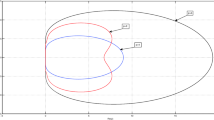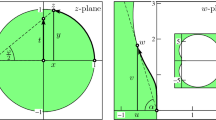Abstract
We investigate dense output formulae (also known as continuous extensions) for strong stability preserving (SSP) Runge–Kutta methods. We require that the dense output formula also possess the SSP property, ideally under the same step-size restriction as the method itself. A general recipe for first-order SSP dense output formulae for SSP methods is given, and second-order dense output formulae for several optimal SSP methods are developed. It is shown that SSP dense output formulae of order three and higher do not exist, and that in any method possessing a second-order SSP dense output, the coefficient matrix A has a zero row.

Similar content being viewed by others
References
Bellen, A.: Contractivity of continuous Runge–Kutta methods for delay differential equations. Appl. Numer. Math. 24(2), 219–232 (1997)
Bellen, A., Vermiglio, R.: Some applications of continuous Runge–Kutta methods. Appl. Numer. Math. 22(1), 63–80 (1996)
Enright, W.H., Jackson, K.R., Nørsett, S.P., Thomsen, P.G.: Interpolants for Runge–Kutta formulas. ACM Trans. Math. Softw. 12(3), 193–218 (1986)
Gottlieb, Sigal, Ketcheson, David I., Shu, Chi-Wang: High order strong stability preserving time discretizations. J. Sci. Comput. 38(3), 251–289 (2009)
Gottlieb, Sigal, Ketcheson, David I., Shu, Chi-Wang: Strong Stability Preserving Runge–Kutta and Multistep Time Discretizations. World Scientific, Singapore (2011)
Hairer, E., Nørsett, S.P., Wanner, G.: Solving Ordinary Differential Equations I: Nonstiff Problems. Springer Series in Computational Mathematics, 2nd edn. Springer, Berlin (1993)
Jeltsch, Rolf: Reducibility and contractivity of Runge–Kutta methods revisited. BIT Numer. Math. 46(3), 567–587 (2006)
Macdonald, Colin B., Gottlieb, Sigal, Ruuth, Steven J.: A numerical study of diagonally split Runge–Kutta methods for PDEs with discontinuities. J. Sci. Comput. 36(1), 89–112 (2008)
Shu, Chi-Wang, Osher, Stanley: Efficient implementation of essentially non-oscillatory shock-capturing schemes, II. J. Comput. Phys. 83(1), 32–78 (1989)
Spiteri, Raymond J., Ruuth, Steven J.: A new class of optimal high-order strong-stability-preserving time discretization methods. SIAM J. Numer. Anal. 40, 469–491 (2002)
Torelli, Lucio: A sufficient condition for GPN-stability for delay differential equations. Numer. Math. 59(1), 311–320 (1991)
Zennaro, Marino: Natural continuous extensions of Runge–Kutta methods. Math. Comput. 46(173), 119–133 (1986)
Acknowledgements
We thank an anonymous referee for several suggestions that improved the presentation of this work.
Author information
Authors and Affiliations
Corresponding author
Additional information
Adil Kusmanov: This work was supported by the King Abdullah University of Science and Technology (KAUST), 4700 Thuwal, 23955-6900, Saudi Arabia. The second author was also supported by the Department of Numerical Analysis, Eötvös Loránd University, and the Department of Differential Equations, Budapest University of Technology and Economics, Hungary. The last two authors were supported by the KAUST Visiting Student Research Program.
Appendix: Some Complete Methods in Shu–Osher Form
Appendix: Some Complete Methods in Shu–Osher Form
We have worked with methods in Butcher form because of the simplicity of the order conditions in that form. In this “Appendix” we write out some of the methods with dense output in Shu–Osher form, since this is usually the most convenient form for implementation. For the sake of brevity we write the methods in autonomous form and let \({\mathcal {C}}={\mathcal {C}}(A,b,\overline{{{\varvec{b}}}})\).
The dense output in Shu–Osher form is
where
We denote each method by SSP\((s,p,{\overline{p}})\), where s is the number of stages, p is the order of the method (A, b), and \({\overline{p}}\) is the order of the dense output.
1.1 SSP(2,2,2)
This method has \({\mathcal {C}}(A,b,\overline{{{\varvec{b}}}}) = 1\).
1.2 SSP(3,2,2)
This method has \({\mathcal {C}}(A,b,\overline{{{\varvec{b}}}}) = 2\).
1.3 SSP(3,3,2)
This method has \({\mathcal {C}}(A,b,\overline{{{\varvec{b}}}}) = 1\).
Rights and permissions
About this article
Cite this article
Ketcheson, D.I., Lóczi, L., Jangabylova, A. et al. Dense Output for Strong Stability Preserving Runge–Kutta Methods. J Sci Comput 71, 944–958 (2017). https://doi.org/10.1007/s10915-016-0331-5
Received:
Revised:
Accepted:
Published:
Issue Date:
DOI: https://doi.org/10.1007/s10915-016-0331-5




